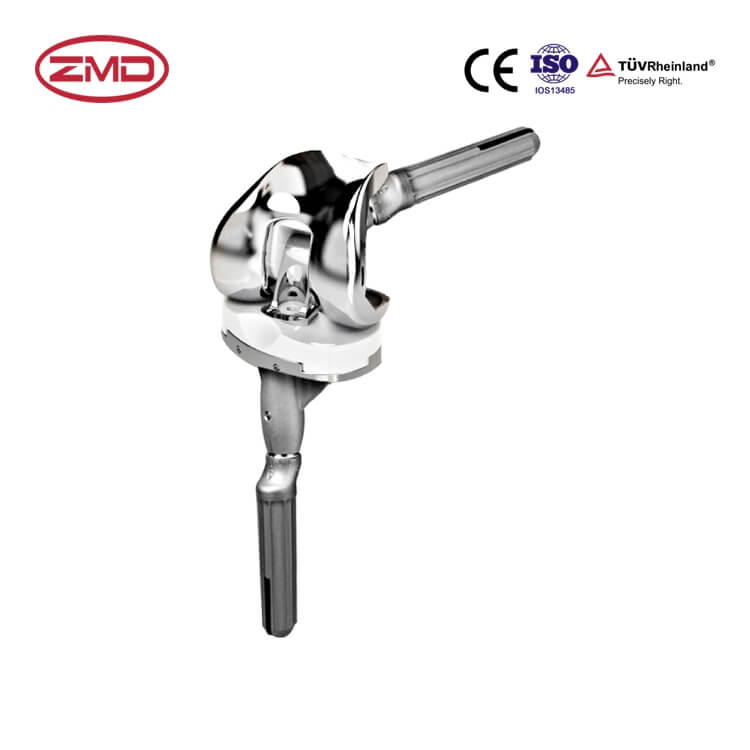
- Home
- About Us
- Products
- Trauma Internal Fixation System
- Spinal Internal Fixation System
- External Fixation
- Artificial Implants System
- Sports Medicine
- Power tools
- VSD System
- Instruments
- Medical supplies
- Blog
- Personnel Profile
- Contact Us
Phone line
| Code | Product Name | Material | Specification |
| 80210 | SKI™ Tibial Bearing (PS) Concept: Biomet Vanguard |
Germany UHMWPE | 1# 8/10/12/14mm (for Tray 1#) AP:38mm ML59mm 2# 8/10/12/14mm (for Tray 2, 3#) AP:41/43mm ML63/67mm 4# 8/10/12/14mm (for Tray 4, 5#) AP:46/48mm ML71/75mm 6# 8/10/12/14mm (for Tray 6, 7#) AP:51/53mm ML79/83mm |
Key Features and Benefits of Tibial Bearing
Tibial Bearing is a specialized orthopedic implant designed to provide a smooth and durable articulating surface in knee joint replacement procedures. This essential component is available in various materials, such as polyethylene or ceramic, to suit specific patient needs and preferences. Tibial Bearings are engineered for enhanced durability and wear resistance, ensuring long-lasting performance. By restoring natural knee joint motion and reducing friction, Tibial Bearings contribute to improved function, reduced pain, and enhanced patient outcomes. These bearings are compatible with different knee joint implant systems, offering versatility and adaptability in surgical procedures. Overall, Tibial Bearings play a crucial role in the success of knee joint replacement, providing a reliable and effective solution for patients seeking improved knee health and function.
Indications for Tibial Bearing
Tibial Bearing is a specialized orthopedic implant designed for use in knee joint replacement procedures. It is indicated for patients who:
How Does The Tibial Bearing Work
Tibial Bearing is a specialized orthopedic implant designed to provide a smooth and durable articulating surface in knee joint replacement procedures. It is typically made from a high-molecular-weight polyethylene (HMWPE) material, which is known for its excellent wear resistance and biocompatibility.
During knee joint replacement surgery, the damaged tibial component is removed and replaced with the Tibial Bearing. The bearing is securely attached to the tibial component using specialized fixation techniques, such as screws or cement. The femoral component, which includes the femoral condyle, then articulates against the Tibial Bearing, creating a smooth and natural gliding surface.
The Tibial Bearing plays a crucial role in the success of knee joint replacement. It provides a durable and low-friction surface for the femoral component to articulate against, reducing wear and tear and minimizing pain. The biocompatibility of the material ensures minimal tissue reaction and long-term durability, contributing to improved joint function and patient satisfaction.
FAQ
Q1: What is a Tibial Bearing?
A: A Tibial Bearing is a specialized orthopedic implant designed to provide a smooth and durable articulating surface in knee joint replacement procedures.
Q2: What is the role of the Tibial Bearing in a knee joint replacement?
A: The Tibial Bearing provides a smooth and durable surface for the femoral component to articulate against, reducing friction and wear.
Q3: What materials are Tibial Bearings typically made from?
A: Tibial Bearings are commonly made from high-molecular-weight polyethylene (HMWPE), but other materials such as ceramic may also be used.
Q4: How is the Tibial Bearing secured in place during knee joint replacement surgery?
A: The Tibial Bearing is typically secured in place using screws or cement, depending on the specific surgical technique and patient anatomy.
Q5: What are the potential benefits of using a Tibial Bearing in knee joint replacement?
A: Tibial Bearings offer several benefits, including reduced pain, improved joint function, enhanced mobility, and increased durability.
Q6: Are there different types of Tibial Bearings available?
A: Yes, Tibial Bearings come in various materials and designs to suit different patient needs and surgical techniques. Some common types include fixed-bearing and mobile-bearing designs.
Q7: What are the potential risks associated with using a Tibial Bearing?
A: As with any surgical procedure, there are potential risks such as infection, implant loosening, and dislocation. However, modern Tibial Bearings are designed to minimize these risks.
Q8: How long does a Tibial Bearing typically last?
A: The lifespan of a Tibial Bearing can vary depending on individual factors, but they are generally designed to provide long-term durability and function.
Q9: Can a Tibial Bearing be replaced if it becomes damaged or worn?
A: In some cases, a damaged or worn Tibial Bearing can be replaced through a revision surgery.
Q10: How does a Tibial Bearing compare to other components in knee joint replacement?
A: The Tibial Bearing is a critical component in knee joint replacement, working in conjunction with the femoral component and other implants to provide a functional and durable joint.
Oh yeah! I have to mention their payment options and discount offers, which are awesome! Those payment methods are as flexible as moving water and can be chosen freely according to our cash flow situation. And the frequent discounts, like a timely rain, have been moisturizing our financial statements time and again, and have had a rocket-like positive impact on our profits! With ZMD, I feel relaxed and at ease when it comes to purchasing!
Send us a message if you have any questions or request a quote. Our experts will give you a reply within 24 hours and help you select the right valve you want.
Book Now
If you are looking for professional orthopedic medical product solutions, don’t hesitate to contact us now!

We are an integrated manufacturer specializing in orthopedic medical industry, providing high quality and reliable orthopedic medical products to customers worldwide.
Copyright © 2024 ASK Project